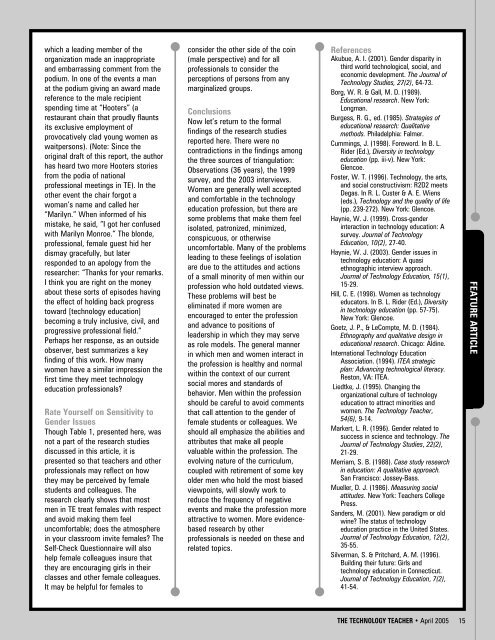Teaching Elements and Principles of Bridge Design - International ...
Teaching Elements and Principles of Bridge Design - International ...
Teaching Elements and Principles of Bridge Design - International ...
Create successful ePaper yourself
Turn your PDF publications into a flip-book with our unique Google optimized e-Paper software.
FEATURE ARTICLE<br />
which a leading member <strong>of</strong> the<br />
organization made an inappropriate<br />
<strong>and</strong> embarrassing comment from the<br />
podium. In one <strong>of</strong> the events a man<br />
at the podium giving an award made<br />
reference to the male recipient<br />
spending time at “Hooters” (a<br />
restaurant chain that proudly flaunts<br />
its exclusive employment <strong>of</strong><br />
provocatively clad young women as<br />
waitpersons). (Note: Since the<br />
original draft <strong>of</strong> this report, the author<br />
has heard two more Hooters stories<br />
from the podia <strong>of</strong> national<br />
pr<strong>of</strong>essional meetings in TE). In the<br />
other event the chair forgot a<br />
woman’s name <strong>and</strong> called her<br />
“Marilyn.” When informed <strong>of</strong> his<br />
mistake, he said, “I got her confused<br />
with Marilyn Monroe.” The blonde,<br />
pr<strong>of</strong>essional, female guest hid her<br />
dismay gracefully, but later<br />
responded to an apology from the<br />
researcher: “Thanks for your remarks.<br />
I think you are right on the money<br />
about these sorts <strong>of</strong> episodes having<br />
the effect <strong>of</strong> holding back progress<br />
toward [technology education]<br />
becoming a truly inclusive, civil, <strong>and</strong><br />
progressive pr<strong>of</strong>essional field.”<br />
Perhaps her response, as an outside<br />
observer, best summarizes a key<br />
finding <strong>of</strong> this work. How many<br />
women have a similar impression the<br />
first time they meet technology<br />
education pr<strong>of</strong>essionals?<br />
Rate Yourself on Sensitivity to<br />
Gender Issues<br />
Though Table 1, presented here, was<br />
not a part <strong>of</strong> the research studies<br />
discussed in this article, it is<br />
presented so that teachers <strong>and</strong> other<br />
pr<strong>of</strong>essionals may reflect on how<br />
they may be perceived by female<br />
students <strong>and</strong> colleagues. The<br />
research clearly shows that most<br />
men in TE treat females with respect<br />
<strong>and</strong> avoid making them feel<br />
uncomfortable; does the atmosphere<br />
in your classroom invite females? The<br />
Self-Check Questionnaire will also<br />
help female colleagues insure that<br />
they are encouraging girls in their<br />
classes <strong>and</strong> other female colleagues.<br />
It may be helpful for females to<br />
consider the other side <strong>of</strong> the coin<br />
(male perspective) <strong>and</strong> for all<br />
pr<strong>of</strong>essionals to consider the<br />
perceptions <strong>of</strong> persons from any<br />
marginalized groups.<br />
Conclusions<br />
Now let’s return to the formal<br />
findings <strong>of</strong> the research studies<br />
reported here. There were no<br />
contradictions in the findings among<br />
the three sources <strong>of</strong> triangulation:<br />
Observations (36 years), the 1999<br />
survey, <strong>and</strong> the 2003 interviews.<br />
Women are generally well accepted<br />
<strong>and</strong> comfortable in the technology<br />
education pr<strong>of</strong>ession, but there are<br />
some problems that make them feel<br />
isolated, patronized, minimized,<br />
conspicuous, or otherwise<br />
uncomfortable. Many <strong>of</strong> the problems<br />
leading to these feelings <strong>of</strong> isolation<br />
are due to the attitudes <strong>and</strong> actions<br />
<strong>of</strong> a small minority <strong>of</strong> men within our<br />
pr<strong>of</strong>ession who hold outdated views.<br />
These problems will best be<br />
eliminated if more women are<br />
encouraged to enter the pr<strong>of</strong>ession<br />
<strong>and</strong> advance to positions <strong>of</strong><br />
leadership in which they may serve<br />
as role models. The general manner<br />
in which men <strong>and</strong> women interact in<br />
the pr<strong>of</strong>ession is healthy <strong>and</strong> normal<br />
within the context <strong>of</strong> our current<br />
social mores <strong>and</strong> st<strong>and</strong>ards <strong>of</strong><br />
behavior. Men within the pr<strong>of</strong>ession<br />
should be careful to avoid comments<br />
that call attention to the gender <strong>of</strong><br />
female students or colleagues. We<br />
should all emphasize the abilities <strong>and</strong><br />
attributes that make all people<br />
valuable within the pr<strong>of</strong>ession. The<br />
evolving nature <strong>of</strong> the curriculum,<br />
coupled with retirement <strong>of</strong> some key<br />
older men who hold the most biased<br />
viewpoints, will slowly work to<br />
reduce the frequency <strong>of</strong> negative<br />
events <strong>and</strong> make the pr<strong>of</strong>ession more<br />
attractive to women. More evidencebased<br />
research by other<br />
pr<strong>of</strong>essionals is needed on these <strong>and</strong><br />
related topics.<br />
References<br />
Akubue, A. I. (2001). Gender disparity in<br />
third world technological, social, <strong>and</strong><br />
economic development. The Journal <strong>of</strong><br />
Technology Studies, 27(2), 64-73.<br />
Borg, W. R. & Gall, M. D. (1989).<br />
Educational research. New York:<br />
Longman.<br />
Burgess, R. G., ed. (1985). Strategies <strong>of</strong><br />
educational research: Qualitative<br />
methods. Philadelphia: Falmer.<br />
Cummings, J. (1998). Foreword. In B. L.<br />
Rider (Ed.), Diversity in technology<br />
education (pp. iii-v). New York:<br />
Glencoe.<br />
Foster, W. T. (1996). Technology, the arts,<br />
<strong>and</strong> social constructivism: R2D2 meets<br />
Degas. In R. L. Custer & A. E. Wiens<br />
(eds.), Technology <strong>and</strong> the quality <strong>of</strong> life<br />
(pp. 239-272). New York: Glencoe.<br />
Haynie, W. J. (1999). Cross-gender<br />
interaction in technology education: A<br />
survey. Journal <strong>of</strong> Technology<br />
Education, 10(2), 27-40.<br />
Haynie, W. J. (2003). Gender issues in<br />
technology education: A quasi<br />
ethnographic interview approach.<br />
Journal <strong>of</strong> Technology Education, 15(1),<br />
15-29.<br />
Hill, C. E. (1998). Women as technology<br />
educators. In B. L. Rider (Ed.), Diversity<br />
in technology education (pp. 57-75).<br />
New York: Glencoe.<br />
Goetz, J. P., & LeCompte, M. D. (1984).<br />
Ethnography <strong>and</strong> qualitative design in<br />
educational research. Chicago: Aldine.<br />
<strong>International</strong> Technology Education<br />
Association. (1994). ITEA strategic<br />
plan: Advancing technological literacy.<br />
Reston, VA: ITEA.<br />
Liedtke, J. (1995). Changing the<br />
organizational culture <strong>of</strong> technology<br />
education to attract minorities <strong>and</strong><br />
women. The Technology Teacher,<br />
54(6), 9-14.<br />
Markert, L. R. (1996). Gender related to<br />
success in science <strong>and</strong> technology. The<br />
Journal <strong>of</strong> Technology Studies, 22(2),<br />
21-29.<br />
Merriam, S. B. (1988). Case study research<br />
in education: A qualitative approach.<br />
San Francisco: Jossey-Bass.<br />
Mueller, D. J. (1986). Measuring social<br />
attitudes. New York: Teachers College<br />
Press.<br />
S<strong>and</strong>ers, M. (2001). New paradigm or old<br />
wine? The status <strong>of</strong> technology<br />
education practice in the United States.<br />
Journal <strong>of</strong> Technology Education, 12(2),<br />
35-55.<br />
Silverman, S. & Pritchard, A. M. (1996).<br />
Building their future: Girls <strong>and</strong><br />
technology education in Connecticut.<br />
Journal <strong>of</strong> Technology Education, 7(2),<br />
41-54.<br />
THE TECHNOLOGY TEACHER • April 2005 15
















